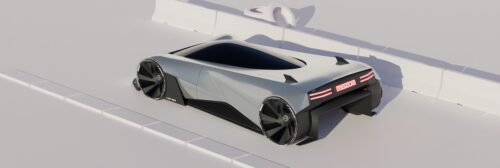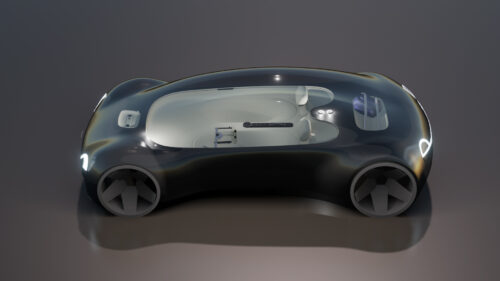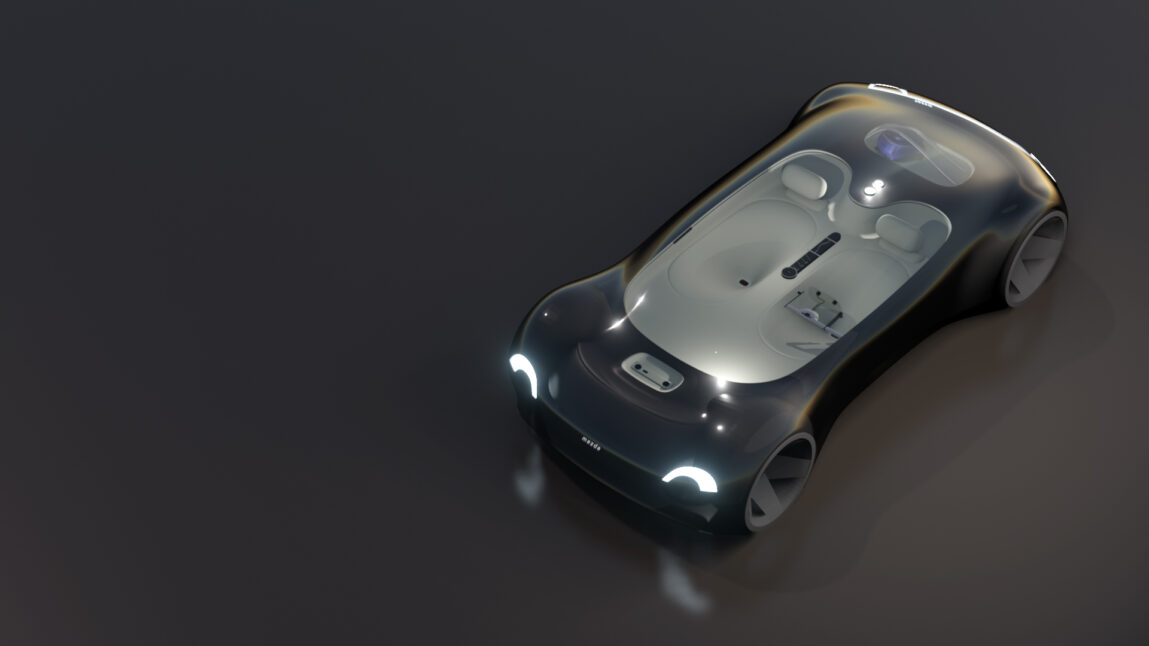Six pioneering and exciting design concepts emerged from the cooperation between the Japanese car manufacturer Mazda and the Munich University of Applied Sciences. In a two-part feature, Chapter presents some of the most outstanding projects.
»We at Mazda hope that this cooperation will give the young and therefore future generation a new perspective on the brand«, announced Bahram Partaw, Senior Designer at Mazda Europe, at the launch of the Japanese car manufacturer’s cooperation with the Munich University of Applied Sciences. While 35 students were still looking forward to getting their design project off the ground at the beginning, there were a total of ten, of whom six emerged as favorites in the end. Leon Galuzzi ultimately emerged as the winner with his project »Royal Blood« – and can now continue to demonstrate his skills as an intern at Mazda Europe.

His design concept is also the best example of how new perspectives are often fed by the history of a traditional brand. The idea for his concept came to him directly at the launch event at the Mazda Classic Museum in Augsburg, he explains. »There was a model of a prototype of the 787b which won the 24 Hours of Le Mans in 1991, setting a historic milestone for Mazda. When I saw this, the idea of reviving the emotion of this car was born.« With Le Mans celebrating its centenary, the timing could not have been better – as the research of the young, motorsport-enthusiastic designer later revealed. Galuzzi ultimately designed a car »that is reminiscent of the 787b in both its grace and its details and at the same time promotes Mazda’s new Kodo design language.« He set himself the goal of developing a trackday car with an uncompromising focus on the driver and the connection to the road. »I also wanted to design a vehicle that could be seen on posters in childrens’ rooms. Something worth dreaming about«, he adds.

»Royal Blood«
The young designer, who is certain that the automobile of the future will be less of a status symbol and more of an expression of individuality, began his project with a precise analysis of the design language of the 787b and a mood board. »Then I thought on paper, so I simply sketched as much as possible to generate a wide range of geometric ideas«, says Galuzzi, who, as he adds, »likes to start oldschool on paper«. It was also fundamental to his design that, »even though it is a performance car, it still has an aesthetic appeal. Cleanness is retained.« What does that mean in detail? Galuzzi answers: »Large, uninterrupted surfaces and clear volume divisions as well as an atypical feature line are key characteristics of the final design for me.« Overall, simplicity is always his top priority in terms of design. »I enjoy a consistently implemented idea without interference«, he sums it up. His design is the best proof that this does not automatically rule out being a fan of imperfection. »Imperfection makes an object human. The things that might bother you about a design at first or that you get hung up on are often the things you love the design for later.«

»Kaido«
The young designer Niklas Künzer also believes that although sharing and public mobility solutions are becoming increasingly important, there will continue to be a need and fascination for exciting automotive design concepts that will hang as posters in childrens’ rooms of the next generation. As a fan of the Mazda brand and Japanese car culture, it was a great honor for him, as he explains in the interview, to show his own ideas and personal style in a design project. »With my all-electric Mazda KAIDO concept, I want to create a vision for the brand’s next legendary enthusiast vehicle. This target group in particular is often critical of electric drives and fears that many emotions will be lost. My aim was to generate excitement in a new way with strong recognition value and Kodo’s brand-typical design language«, says Künzer. To explain his design approach in more detail, he adds: »Mazda KAIDO works with a central color gradient that symbolizes the electric power when the vehicle is started and shows transparency and light effects. The proportions and volume of the concept are also a reinterpretation of the classic sports car shape established by Mazda, among others. This resulted in a combination of clean surfaces and futuristic details.«

When implementing his projects, the young designer is always keen to define a style that runs through every presentation slide, every sketch and, ultimately, every rendering. Hand sketches form the basis of every design project, which he then develops further with digital renderings. »However, the step to a first 3D model is the decisive one for me«, he adds in conclusion. He always kept the brand’s central philosophy of Jinba Ittai, the unity of driver and vehicle, in mind during all these steps. Sustainability is also an important topic for Niklas Künzler, who counts concept artists Scott Robertson, Carlos Pecino and Khyzyl Saleem among his role models. »Design must make ideas for sustainable concepts attractive and desirable«, he says. »My personal goal is always to arouse emotions with my designs. And I think that this emotional design will be of great importance in convincing our society of sustainability.«

»Aibo«
»Mazda has also shown me that traditional principles can also be reinterpreted in the future«, is a key idea that student Austin Reimann has learned from the collaboration with Mazda. And here we are again at the bridge between tradition and new perspectives that the two cooperation partners sought to build with their project. But now back to Austin Reimann, who, as he explains, has been attracted to Japanese automotive design since his childhood. »Iconic vehicles such as the MX and RX series have played important roles in various video games and films. From a design perspective, Mazda has made a special impression with the Vision Coupe, RX and Kai concept cars.«

His own concept is called Mazda Aibo, Japanese for partner or friend, and is a semi-autonomous vehicle concept that combines the Jinba Ittai-design principle in a playful new way. Reimann sums it up as follows: »In this case, the connection between man and machine is created by the occupant sinking into an enclosing material. Formally inspired by the character Baymax from the Disney film of the same name, a calm and friendly design language is important in order to evoke a feeling of friendship and security. With an embracing gesture in the interior, artificial intelligence and the associated interaction, the car can be a daily companion and therefore so much more than just an object.« For him, good automotive design is expressed in a clear design language and a reduction to the essentials, among other things. »However, the vehicle must also evoke emotions in you. And that is something absolutely subjective. When I think about why I like certain cars and design styles, it has a lot to do with my experiences as a child and my environment«, he adds.

With his semi-autonomous concept, the young designer is responding to the changes he is observing in the field of mobility. »There will always be car enthusiasts. Nevertheless, the generation after us is already so far advanced that it can do without autonomous driving altogether. For the automotive industry, this means having to come up with something new.« Specifically, for him and the future of his profession, this means »developing solutions for entertainment and interaction, but also creating places to rest or retreat. The design of this use case in the interior will have an impact on the exterior design, if there is a separation between interior and exterior at all.« [SW]

